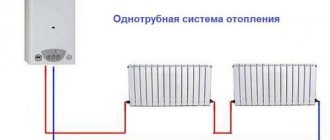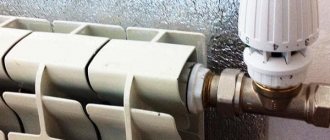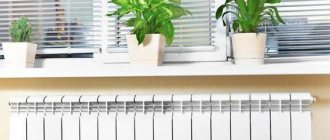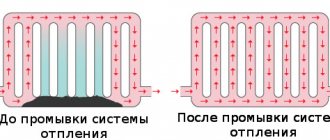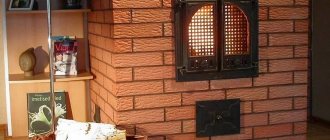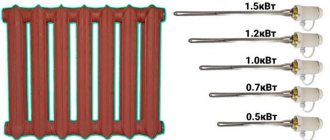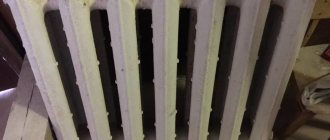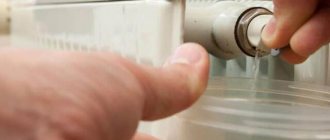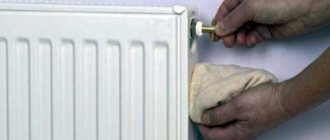The efficiency of heating a living space is largely determined by how well the seasonal work has been done to prepare its heating system for operation. That is why, with the arrival of cold weather, all equipment included in the heating system is checked and, if necessary, repaired. In this case, situations are possible when seemingly serviceable batteries at the beginning of the operational period heat up very little or do not heat up at all.
This is most often explained by the fact that so-called “air plugs” form in the internal space of the batteries. To eliminate them, it is enough to blow out the heating radiator, after which the indicated malfunction, as a rule, disappears.
Reasons for reduced efficiency of heating radiators
Old radiator
There may be several reasons for this. The first and probably the most common is the formation of an air lock. How and why it is formed is another question. But one thing is clear: the presence of such a plug in the pipeline or heating radiator slows down the progress of the coolant or stops it altogether.
The second reason for cooling the heating radiator is the presence of debris in the pipes and radiator, that is, scale and large particles. They move along with the coolant through the heating system. The practice of operating heating systems shows that a narrowing of the internal diameter by 1 - 2 mm, due to the formation of scale on the walls, leads to a decrease in the thermal output of the heating battery by 15%, or even more. That is why before the start of the heating season it is necessary to clean the heating radiator in the house.
Steel
• threaded pipes: inexpensive, available in various types of shapes • seamless: available in various nominal diameters; but: have low corrosion resistance and high resistance to flow • galvanized: resistant to corrosion; but: have high resistance to flow • made of stainless steel: resistant to corrosion, have low resistance to flow, sealed; but: they have a limited number of types of forms, expensive.
• corrosion resistant, low flow resistance; but they require a high technical level for laying and soldering the pipeline.
How can you tell if there is air in the batteries?
To do this, you need to listen to how your heating system works. Very often gurgling or overflowing of water is observed. If there is no air in the system, you should not hear any gurgles or sounds. Another sign of air in the system is the temperature difference in different parts of the battery.
That is, the battery is hot at the bottom, cold at the top, or vice versa. Half the pipe can be hot and half cold. In this case, most often the riser is quite hot. This indicates that heating is still supplied to the system, but does not work due to the fact that air has accumulated in the radiator.
The battery does not heat up
Diagnostics
To understand what caused the drop in radiator efficiency, you need to perform a few simple manipulations.
The first sign that the inner walls of the pipe and radiator are covered with scale will be that the riser along which the coolant moves is significantly warmer than the radiator. The second sign that the pipelines are clogged is different temperatures of batteries installed in the same room or on the same line. The third sign is different heating of sections mounted in one radiator.
Preparing to remove air pockets
De-airing scheme
Before blowing out the radiators, you should first take care of the tool used during repair work. The working kit should include the following items:
- key for adjusting the Mayevsky valve;
- screwdriver and adjustable wrench;
- small container (best of all, a bucket);
- WD-40 washing liquid (kerosene) and rags for wiping.
It is imperative to make sure that it is the air pockets that are the actual cause of the detected malfunction.
If the batteries do not heat up well
You can verify this by the characteristic and clearly distinguishable “gurgling” in the batteries, which do not heat up well, despite the fact that hot water regularly enters the system. After finding out the reasons for the lack of normal heating of the heating radiators, you can safely begin removing the plugs.
How to bleed radiators: how to bleed air from the system using a Mayevsky tap?
Quite often, after heating is applied to the radiator, some areas may remain cold. This usually occurs at the top of the radiator, which indicates that the system is air-filled.
Instructions:
- The method of purging and cleaning the battery depends on the design of the entire system. In private houses, a bleeding system is usually installed on such radiators, which is a Mayevsky tap. It's a kind of valve.
- In order to bleed the air, you need to take a screwdriver, wrap the circumference of this tap with a cloth, place a container under the radiator, and gradually begin to unscrew it. If there is indeed air in the system, you will hear a hissing sound.
- This suggests that air bubbles are indeed being purged from the system, and it is filling with water. As soon as everything stops hissing, a thin stream of water begins to come out instead of air, you need to tighten the tap with a screwdriver and wipe the battery dry.
Radiator with Mayevsky tap
Process description
Loosen the screw
Insert the working tip of the screwdriver into the screw slot on the Mayevsky tap. Rotate counterclockwise. There is no need to completely unscrew the screw. Firstly, this will not speed up the process of bleeding air, since the hole for its release is very small. Secondly, there is a possibility that after finishing the work it will be difficult for you to screw the screw into place, since strong pressure will not allow you to do this. One or two turns of the screw are enough to open the tap. Do not use excessive force to avoid damaging the valve.
Let the air escape
As soon as you loosen the screw, you will hear a hissing sound coming from the radiator. Don't be alarmed - it's air. It comes out of a side hole on the faucet. By the way, a small amount of water will come out along with it, so it is recommended to lay a rag on the floor. Through a small hole, water will either flow in a thin stream or simply drip. But it’s still better to place a small container under the tap.
Tip: the position of the air outlet hole can be adjusted - it is better to lower it down so that the water drips into the container instead of splashing on the wall.
Close the tap
How do you know when the process is finished? When a steady stream of water flows without bubbles and the hissing stops. The screw can be tightened: insert a screwdriver into the slot and rotate clockwise until water stops dripping. That's all - the air is out, the radiator is completely filled with hot water. Now you know how to use the Mayevsky tap and how to bleed air from the heating system yourself. This means that the heating system in your home will function correctly and heating efficiency will improve.
Source
How to blow out radiators: instructions
What is harmful about airing the system? This not only reduces the temperature in the room, but also often causes very rapid destruction of heating radiators. That is, the radiator wears out faster. The fact is that in a system in which there is air, scale forms in these areas, and the batteries overheat in those areas where there is water and are cold, where air is contained. Over time, such batteries deteriorate very quickly and can cause leaks. The main disadvantage is the low room temperature. What to do if the system does not include a Mayevsky tap?
Instructions:
- In this case, you need to find the highest point in the house. If this is an apartment building, then this point is located directly at the very top of the heating system; they are often mounted on the roof.
- It is necessary to open the corresponding valve and bleed the air. Often such valves, as well as taps, are installed at home. If you do not have them, then we advise you to take care of installing this faucet on batteries in the summer.
- The work is really painstaking and not cheap, but it will allow you to significantly improve and increase the temperature in the room during the heating season.
Heating system installation
Stages of preservation of home water supply
Next, we will talk about the procedure for preserving the water supply system at the dacha for the winter. The whole process is done in several stages:
- Turn off the water at the entrance to the house;
- Open all plugs in the home branch of the pipeline;
- Prepare cans, rags and containers. Since water can escape from all open parts of the pipeline;
- Connect the compressor to the vented part of the pipeline;
- Turn on the compressor; when air comes out, it means the water supply system is preserved and therefore will not be damaged by frost.
Descaling using the blowing method
Deposits in the battery
A fairly common reason for poor heating of radiators in an apartment is the deposition of scale and foreign particles on their walls, which enter the heating system along with hot water.
Studies have shown that with a scale deposit thickness of only 1 mm, the heat transfer of the battery decreases by 15%. That is why, before the start of the operating season, it is advisable to vent the heating system in accordance with the recommendations of specialists.
But first you will need to make sure that it is scale that is causing the problems that have arisen, which is usually accompanied by the following characteristic manifestations:
- If a thick layer of scale forms, the heating system riser is somewhat hotter than the radiators themselves.
- When examining radiators by touch, different degrees of heating are revealed in different blocks.
- There is uneven heating of individual sections within one battery.
Once you are finally convinced of the presence of scale, you can proceed to choosing the most suitable method for removing it at home. At the same time, you should know that the most effective, but at the same time the most expensive, is the method of hydraulic purging of the system, which is widely used along with other well-known cleaning methods (such as chemical treatment, for example).
Hydraulic cleaning
As noted earlier, hydraulic purging of the heating system is the most effective method of cleaning batteries from scale accumulated on their walls.
Heating flushing
When implementing this method, a working mixture consisting of ordinary water and compressed air is supplied to the operating riser under high pressure. To obtain it at home, you will need a compressor of appropriate power that provides the required pressure in the channel being cleaned and guarantees the removal of scale accumulated on the walls of the batteries.
Practice has shown that for modern apartments with cast iron radiators, the hydraulic blowing method is the most suitable option for organizing cleaning work. If implementing this method at home is impossible, you can dismantle the batteries and take them for cleaning to a service center that has all the necessary equipment for this.
Generalization on the topic
During operation of any heating system, scale forms on the inner walls of metal elements, which must be removed periodically. Otherwise, the mechanical wear of the heating device accelerates significantly and the heating efficiency decreases. Cleaning the batteries helps to avoid all this, which can be done using several methods.
Let's figure out how to connect a heating battery in an apartment
Types of piping, or how to properly connect a heating battery
Heating a house using electrical energy
How to replace a heating battery using gas welding
How to choose a heating battery for your own home?
Source
Causes of air locks in batteries
In order to avoid the occurrence of air jams in the future, it is necessary to know the reasons for their occurrence. There may be several such reasons. The main reasons that lead to the formation of an air lock are:
When water is heated, oxygen is released from it, and when it evaporates, it forms air, which accumulates at the top of the radiator. This creates a plug that does not allow water to circulate through the system.
It may also appear after repair work. The heating repair field, the company that carried out the repair, must bleed the system. But this is a lengthy procedure and not all workers perform it, and if they do, it is done partially and carelessly.
We recommend: How to turn on a gas boiler: detailed instructions for starting wall-mounted and floor-standing models of the old and new designs after a long or short break, gas or light outage
One of the reasons for the appearance of air in the batteries may be a seal failure. Typically, depressurization is indicated by a water leak. But this cannot always be seen visually.
A heating leak may not be noticed, since hot water evaporates quite quickly. And in rooms with high humidity (bathroom, kitchen), you may not pay attention to the leak at all, confusing it with natural condensation on the pipes.
It is worth adding that it is necessary to bleed air from the batteries regardless of whether it is an apartment or a private house. If an air lock has formed in the heating of a private home, this will affect not only the heat, but also the wear of parts.
Most often, heating in a private house operates using a pump. If there is an air lock, the pump will work at full power, and the result will be practically zero.
Heating radiators may not work properly not only due to the formation of an air lock. Even after purging, the batteries remain cold. The cause may be clogged radiators.
Stages of conservation of street water supply and automatic watering systems
Street water supply in dachas is often located above the ground or at a depth of up to 0.5 m. Therefore, such systems must be emptied before winter frosts, otherwise the resulting ice will break all the pipes.
It is especially important to blow out all metal pipes, since threaded connections quickly burst in the cold. PVC pipes are not so afraid of frost, but the water still needs to be removed from them; a compressor will also do an excellent job with this task.
Do not forget to remove water from storage tanks for irrigation, outdoor showers and other containers. All ball valves must be left open, then they will easily survive the winter and can be used in the future.
Methods for cleaning heat pipes and radiators
In order to properly eliminate air pockets or scale, it is permissible to use several methods, the main ones are given below:
- hydraulic;
- individual;
- using soda ash;
- pulse;
- chemical.
Let's try to figure out what is their difference from each other.
Hydraulic method
Perhaps this is the most effective and at the same time the most expensive method. To implement this you will need an air compressor. With its help, an air-water mixture is pumped into the riser. High pressure creates a situation that leads to scale separation from the walls of the pipe or radiator. This cleaning method is most effective for cast iron radiators. Hydraulic cleaning does not require the use of any chemicals and can rightfully be described as environmentally friendly. But to properly clean the batteries, the homeowner must disconnect the batteries and take them to a specialized service center that has such a compressor. And then the question of how to properly blow out heating radiators will be taken off the agenda. When using this method, it is permissible to use softening agents. To remove traces of them, simply rinse the radiator with clean water.
Individual cleaning
It is advisable to carry out the hydraulic cleaning method when all the neighbors in a city (apartment) building have nothing against such work and are ready to participate in cleaning the heating system, and before blowing out the radiators in the apartment, you will have to coordinate this issue with them. Otherwise, all cleaning will go down the drain. And at the beginning of the heating season, the pipes and radiators will clog again.
If the homeowner does not want to communicate with the neighbors, then how to vent the heating radiator in the apartment? Individual cleaning can and should be done. To do this, you need to dismantle the radiators and wash them in the bathroom. The washing procedure is simple. To perform this, the battery must be disconnected from the network and transferred to the bath. Hot water must be supplied to one hole, and the battery must be constantly turned over. For greater effect, it is permissible to use a plumbing cable with a brush. Flushing is completed when more or less clean water begins to flow from the radiator.
Flushing a heating radiator using caustic (technical) soda
Caustic soda
The procedure for washing using technical soda is practically no different from that described above. The only thing is that all the holes in the radiator are plugged except one. Boiling water is poured into it and soda is added. After this, the radiator can be left alone for a certain time.
The use of technical soda causes the plaque inside the pipes and radiator to become soft and fall off the walls. To speed up the process, you can use a rubber or ceramic mallet. You can tap it on the battery case. This procedure is continued until clean water comes out of the battery. By the way, instead of technical soda, it is permissible to use special cleaners used for flushing the radiator installed in a car.
Pulse flushing
This method can only be used if you have a special gun. The technological capabilities of this device make it possible to use it for flushing a heating radiator with a distance between the walls of no more than 150 mm. In addition, it is permissible to remove scale at a distance of 50 meters.
Is specialized equipment really necessary? To decide on the purchase of equipment that can be used for cleaning radiators, one must proceed from how often it will be used for its intended purpose. The fact is that this work is carried out once a year, before the start of the heating season, and it is advisable to contact a special service.
On the other hand, cleaning the heat supply system yourself ultimately leads to saving money on calling a service company. In this case, you can buy a specialized pump and its accessories and flush the system yourself. When purchasing such equipment, you must pay attention to the following parameters:
- operating pressure;
- water consumption;
- setting the pulse frequency;
- possibility of using additional detergents.
Chemical washing
In many apartments, the quality of the heating system is far from perfect. Heating radiators, pipes, fittings have long been clogged with scale and the described methods are not enough to eliminate it. In this case, cleaning using chemicals comes to the rescue.
The chemicals used are usually organics, alkalis or solvents. When working with them, you must strictly follow safety regulations, because... these substances are mostly toxic.
But the chemical method has a limitation - it cannot be used for washing aluminum products. This may lead to a violation of their tightness. But, on the other hand, chemistry is very effective when working with cast iron batteries. Before blowing through the battery, it is advisable to check what metal the heating radiators are made of.
To perform work using chemicals, only specialized equipment should be used.
Home heating systems sometimes need cleaning. You can clean both entire pipes and individual parts. It is important for residents of private houses and owners of autonomous heating cycles to know how to bleed the battery themselves.
Feeling the batteries
Prices for renting a compressor for pressure testing and purging
Compressor (5m 3 /min, 7 Atmospheres) on a car base – 7500 rubles (7 hours of work + 1 hour of supply to the site inside the Moscow Ring Road, including fuel and operator maintenance).
| Productivity, m 3 | Working pressure, atm | Fuel consumption, l/h | Weight, kg | Price | Non-cash with VAT |
| Vehicle based | |||||
| 5 | 7 | 10,8 | 900 | 8000 7500 | 8850 |
| Stationary or on chassis (delivery separately) | |||||
| 11 | 7 | 22 | 2040 | 10000 | 11100 |
| 10 | 11 | 25 | 2080 | 12500 | 13800 |
| 15 | 11 | 38 | 3230 | 23000 | 24400 |
| 18,5 | 7 | 45 | 3225 | 23000 | 24400 |
| 21,3 | 7 | 40 | 4400 | 26000 | 28000 |
| 21,3 | 13 | 54 | 5350 | 33500 | 35600 |
Order a compressor for crimping: +7(495)241-3371
Algorithm for cleaning the radiator
- We remove all unnecessary things and furniture from the heating radiator that may interfere with or delay flushing. If there are curtains hanging near it, you need to remove them. In addition, if the room uses laminate or parquet as flooring, then it is necessary to spread some piece of fabric or film under the radiator - this is done so as not to harm the floor.
Before starting work, you must turn off all taps
It is necessary to shut off the water supply to the radiator. If there is no shut-off valve that allows this to be done, then you will have to go the other way - drain the water from the heating system. Take a regular bucket, remove the radiator by unscrewing it from the rest of the equipment, and drain the water present in it into the prepared bucket. The cleaning process is just beginning and then you need to take the heating radiator to the bathroom and then place it in the bathtub. There is a risk of causing mechanical damage to it in the form of scratches, and in order to prevent such a development of events, place something like a wooden pallet under the radiator. If you live in a private house and not in an apartment, then to flush the radiator you will need to take it out into the yard.
The end fittings are unscrewed using a wrench
We unscrew the end fittings using a wrench. This must be done in the yard or in the bathroom, otherwise you can fill the floor with a cloudy and littered liquid that has a very unpleasant odor, and you will create another problem for yourself - you will need to clean the floor.
Next, you need to rinse the heating radiator from the inside; to do this, we supply water under pressure from a hose or shower into the holes at the end.
- Sometimes owners are forced to deal with crystalline blockages, and in this case slightly different means are needed. You can't do without a concentrated vinegar solution. We install the end fittings at the bottom and pour vinegar inside. Before using vinegar, it is recommended to dilute it 70% with water. This flushing will help remove stubborn blockages from the heating radiator. The solution should sit for about two hours, after which it should be poured out and the radiator should be cleaned with water pressure to achieve complete cleansing.
- You can also wash the external surfaces of the radiator to give it a nice and clean look.
We recommend: Closed heating system for a country house: diagrams, calculations, filling
One of the reasons for clogging may be scale formation
The radiator should be placed on wall mounts and the threaded connections on it should be lightly cleaned with a cloth, which must be dry. If you have a cast iron radiator, then screw tow onto all the fittings in the direction of the threads and apply paint to the seal. It is allowed to use any paint related to “Nitro” and “Enamel”. Using a two-piece gas wrench, tighten the fittings tightly. If the apartment has more modern radiators, then it is recommended to use film for waterproofing purposes. Do not use tow or paint.
So, as we see, there is nothing overly complicated about cleaning the radiator. This will not require any special skills or knowledge, just as you will not need any rare means and tools that are difficult to obtain. If done responsibly, this procedure will not take too much time and effort, and therefore every owner can clean the radiator on their own. However, there are situations where even after all the measures have been taken and the radiators are installed in their place, the heating system still functions poorly. In this case, you need to buy a new radiator and replace the old one, or use the services of specialized companies that carry out cleaning with a technical booster.
Flushing the heating system in a private house
In private homes, cleaning heating radiators is a more pressing problem. This is explained by the fact that the water in the heating system of a private house does not come from pipes, but from wells or reservoirs. The water that comes from pipes in residential buildings is treated, but well water is not. In private homes, radiators become dirty a little faster, as silt or other small particles can accumulate in them, so cleaning radiators will be required more often. If you live in a private house, it is better to flush the entire heating system, and not just the radiators.
Bleeding air from the heating radiator
Cast iron pipes can be washed in the warm season, the main thing is not in winter. Before you wash the radiator and the entire heating system, you need to bleed the air from the radiator, so you will need to unscrew all the valves. If you doubt your abilities, it is better to call a specialist who will not only bleed the air from the heating radiator, but also completely carry out such an operation as cleaning the radiators. If you make even a small mistake, you can damage the equipment or cause a flood.
There is no need to drain water from the heating boiler. The line for the steam line must be completely closed before cleaning the heating radiator. If all the necessary valves are closed and the heating radiators are purged, then you can run water through the heating system. It is necessary to supply water until clean water begins to flow from the pipes.
This method will help clean not only radiators, but also pipes.
To carry out such an operation as flushing a heating radiator more effectively, you can add some chemicals to the water. These include vinegar, soda, whey and others. For washing, a product such as “Mole” or a product for cleaning car radiators is suitable.
If various chemicals are used to clean radiators, you will need to rinse the system thoroughly with water after using them. It is best to flush the system with hot water, and this will require turning on the boiler. A procedure such as cleaning heating radiators should be carried out at least 2 times a year.
How to wash a heating battery without removing it
During long-term operation of a water heating system, all its components and assemblies (boilers, pipes, radiators) eventually become clogged with small mechanical particles present in the water, scale forms on their walls and, as a result, the heat transfer of the system decreases and it no longer works as efficiently as it should. .
Without regular flushing, it is impossible to restore its normal operation and heat transfer. If flushing boilers is the domain of exclusively appropriately equipped professionals, then, say, you can flush the heating radiator (battery) located in the room yourself. Usually, to do this, it is dismantled and taken out of the room, but there is a way to clean the interior of the radiator right at the place of its installation. How to rinse the battery without removing it from the brackets on which it is installed? First, the water from the heating system is drained if possible, the valves on the pipelines supplying and discharging water from the battery are replaced with new ball valves, and one of the pipelines at the bottom of the battery is disconnected. To wash the battery without removing it from the brackets, you will need a small compressor capable of supplying air at a pressure of 13-15 atmospheres, equipped with a special “gun” that meteres the air supply. In the place of the disconnected pipeline, a fitting equipped with a ball valve is installed into the battery. A hose from the compressor gun is connected to it. The second hose from the gun is lowered into the sewer, for example, into the toilet. How heating is flushed: when a portion of air under pressure is supplied to a water-filled battery from a compressor “gun” (shot), the dirt inside it is knocked off the walls, turns into dust, and all this under the air pressure in the system through the check valve of the gun thrown into The toilet hose goes into the sewer.
Flushing the heating battery is considered complete when the water squeezed out of it with air becomes relatively clean. After this, the fitting with the valve is removed from the battery, and a pipe equipped with a ball valve is attached in its place.
This is how you can wash the battery using hydropneumatic washing without removing it from the brackets. Experts recommend carrying it out at least once every four years. The method is simple and the main difficulty is to find and rent a compressor equipped with a gun designed for flushing heating systems.
Compressor types
Compressors operating on various principles can be used to purify water pipes.
different types of air compressors
Piston compressor
Air is compressed in piston cylinders, a direct analogy is the compression of the combustible mixture in an internal combustion engine. Low price, simple design, maintainability. High noise level during operation, impossibility of long-term operation.
Screw compressor
I pump air into two complex-shaped screws in parallel rotation. Low noise level during operation. Low friction between the screws ensures low power consumption. High energy efficiency - a large volume of pumped air per unit of energy spent. The cost is higher than piston compressors, repairs are only carried out under specialized service conditions.
Scroll compressor
Compact size, convenient for use in small spaces, relatively low productivity.
Diaphragm compressor
Similar to a piston, but instead of a metal piston a thin membrane is used. The membrane is driven by a crank mechanism. Low pressure generated, not very high level of performance.
industrial compressor
Compressors are often equipped with a small receiver. This is a durable steel tank in which compressed air is stored. The presence of a receiver allows you to increase the pressure to high values, which the compressor itself cannot provide, and organize a supply of air. As a result, we get an effective replacement for an expensive, powerful compressor.
The compressor is always equipped with a pressure gauge and control means. This is necessary to monitor and correct pressure levels. After purging the water supply system, all drain valves located at the lower points of different pipe branches should be left open.
Cleaning radiators
Contamination of the heating system is a more complex problem, since its elimination often requires dismantling the radiators. Sometimes, if the blockage is not severe or the system is not very extensive, you can wash the heating radiators without removing them. To do this, water is supplied to the system and simultaneously drained. Flushing is more effective when hot water is supplied.
The main signs that indicate the need to wash batteries in the house are as follows:
- uneven heating of different parts of the heating system;
- longer period of reaching operating temperature;
- greater energy consumption to heat the system.
The issue of washing old batteries is especially relevant. After all, the longer the service life, the more deposits accumulate inside.
How to wash a cast iron battery?
Schematic illustration of the radiator flushing process
The most labor-intensive process is washing cast iron batteries. This is explained by the low corrosion resistance of the material and the design of the radiators. How to wash a cast iron battery? First of all, you need to turn off the water. Then the radiator is dismantled and moved to a place where manipulations can begin without fear of damaging the floor or walls.
In a private house, it is more convenient to wash heating radiators outside, in an apartment - you can do this in the bathroom, after first protecting the enamel coating of the bathroom itself from damage. After unscrewing the plugs, a stream of water is directed into the radiator from a hose. This removes the lightest dirt particles. However, this is often not enough, and then chemicals are used to more completely clean cast iron batteries. You just need to remember that using any chemicals is best done with gloves and protective clothing to avoid getting them on the skin.
How can you clean cast iron radiators? This could be concentrated acetic acid or a number of household chemicals used to clean drains. The selected substance is poured into the radiator, the drains are closed and left for several hours. During a chemical reaction, deposits become detached from the inner walls and subsequently merge
We recommend: Do-it-yourself pyrolysis boiler: drawings, principle of operation, photos and video step-by-step instructions
To speed up the process, from time to time the radiator must be turned over or gently tapped on it so as not to damage the outer coating. As you can see, washing cast iron batteries with your own hands is quite an affordable activity.
It can be performed even by a non-specialist plumber.
How to wash radiators made of other materials?
There is no fundamental difference in the process of flushing more modern radiators. It is only necessary to avoid tapping, as this can lead to deformation of the aluminum or casing. And most likely there will be no need for it. Because radiators made of these materials are less susceptible to corrosion than cast iron. After the aluminum heating radiators are removed, they should also be washed under high water pressure. And if necessary, use a chemical solution to dissolve the scale. Another nuance is installation and dismantling. As a rule, removing and installing modern radiators does not require much effort. They are much lighter compared to cast iron. And sealing is carried out in a “cleaner” way - using special gaskets or FUM tape.
Thus, cleaning and blowing radiators, although a rather labor-intensive task, is within the capabilities of almost everyone. If you wash the batteries regularly enough, you can do without dismantling the radiators, and limit yourself to supplying flush water to the heating system with simultaneous draining.
You can clearly see how to wash heating batteries in the video.
Hot and cold H2O - is there a difference in the way the gap is sealed?
It's all about the difference in coolant temperature. It is this factor that is decisive when choosing a material.
With hot pressure, minor damage can heal without outside intervention . Larger gaps can be easily repaired with regular salt and a bandage.
But when the water cools, the flow will resume. It will not be possible to fix a leak in a cold water pipe with salt and a bandage. It is easier to repair a failed hot water pipe in the summer when it is turned off. Then you don’t have to control the temperature in the room while fixing the leak.
Preventive measures
As most people agree, it is still easier to prevent a disease than to treat the consequences it causes. Likewise, with batteries, in order not to be left without heat in cold weather, you need to promptly carry out technical measures to maintain heating radiators, and also install additional devices during installation that will help prevent the formation of blockages and air locks.
For example, Sira heating radiators have a built-in multifunctional deaeration system. During its use, special devices for bleeding air from the system are cut into several places, which allows air to be released separately for each group of heating devices.
In order not to rack your brains about how to blow through an aluminum heating radiator, you just need to promptly install a special device on it - an air vent. There are two types of these devices:
- manual;
- automatic.
The air vents are manual - they are usually installed on the end side of the battery. They are easy to use to bleed air from the heating system. It is enough to turn the bolt with a special key or screwdriver and the air will begin to escape. Given their low performance, such devices are installed only for home use.
Automatic air vents operate completely autonomously. There is no need to bleed air by unscrewing or opening anything, the device does everything themselves. They can be installed vertically or horizontally.
True, such air vents have one significant drawback: they are sensitive to various types of pollution. Therefore, an additional filter will have to be installed in the system to clean strong mechanical contaminants.
When installing Arbonia heating batteries, installing a full set of additional components allows you to free yourself from constant monitoring of the heating system.
For cast iron radiators, you can also install special air vents; this is most important for apartments in multi-storey buildings. In fact, it is much simpler and easier than having to deal with blowing or washing batteries later. In any case, the first option to return heat to the battery is simpler, but if the battery is clogged, nothing other than flushing will help.
In order to flush cast iron radiators, you will first have to completely disassemble the battery using a blowtorch to unscrew the connecting nuts. Then the radiator is disassembled into sections, the nipples (threaded connections between the battery sections) are cleaned, and washed using a hose. All this requires incredible strength, because the weight of each section of a cast iron radiator can reach up to 7 kilograms.
In order to prevent blockages in cast iron batteries, special jumpers must be installed, in which all the dirt settles. In high-rise apartments, the presence of jumpers is simply mandatory. Indeed, often at the beginning of the heating season, the water entering the heating system is, to put it mildly, completely unclean.
After a long period of inactivity, all dirt and rust, as a rule, rush into the heating elements with the first flow of hot water. Needless to say, but, unfortunately, our Russian central heating systems are extremely imperfect.
Helpful advice. If an air lock has formed in your heating system, try to find out the cause of its occurrence, especially if this has not happened before. Try not only to get rid of the air, but also to take measures to prevent a recurrence of this situation. Check the system for leaks at the junctions of pipes and radiators. Perhaps somewhere you need to tighten the bolts, or change the nuts, you may need to re-seal the joints using more tow.
